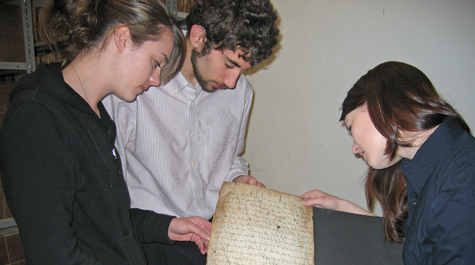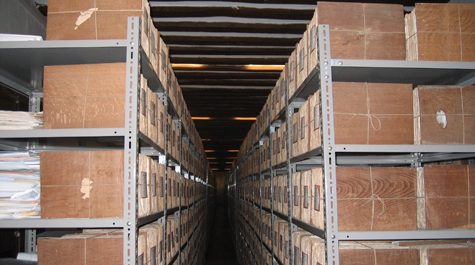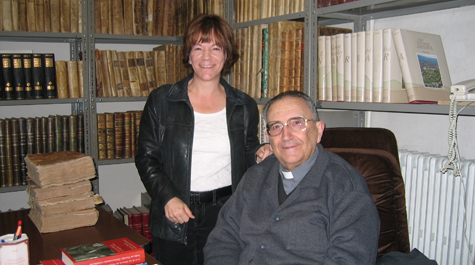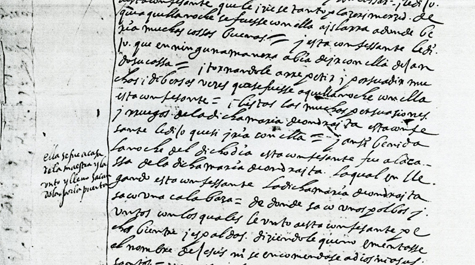Students get rare, hands-on research opportunity in Spanish archives
"He just pulled it out and slapped it down on the table like it was no big deal, and I was trying my hardest not to breathe too hard on the ornately decorated pages of Latin," she said. "The realization that even most of the scholars studying these works wouldn't get to see them in person was pretty incredible."
Bassett was one of three William & Mary undergraduates who joined History Professor Lu Ann Homza on a research trip to Pamplona, Spain over Spring Break to peruse two sets of archives and get a better understanding of Spanish history through the hand-written accounts of the people who lived it.
"I've been at the College since 1992 and have had more than my fair share of wonderful mentoring and teaching moments, but what happened [during Spring Break] was on a whole new level," said Homza.
Homza has travelled to Pamplona for the past three years to conduct research for her next book. Last May, she decided that it would be fantastic to take undergraduates to the two archives she uses for her research: the Archivo Diocesano de Pamplona and the Archivo Real y General de Navarra.
"These two archives hold a breathtaking number of holdings on witchcraft trials, clerical misbehavior, the medieval Jewish population, disputes over jurisdiction among the Inquisition, the viceroy, and the bishop, and so on," she said. "To make matters even better, neither archive is crowded and each has a superlatively helpful staff."
After finding out about the Mellon Foundation's undergraduate research grants through the College's Charles Center, Homza approached the three students - all of whom Homza had taught in previous courses -- about their interest in the trip. All immediately responded in the positive, said Homza.
To prepare for the trip, the students took a once-a-week paleography seminar with Homza during the fall 2008 semester to learn how to read the handwriting. Finally, the group left for Spain on March 6 and returned on March 14.
During the trip, each of the students was required to read texts and "then work to contextualize them," said Homza.
Bassett, a sophomore majoring in history and Chinese, focused on the role of young children during witch trials.
She discovered that both the prosecution and defense during the trials attempted "to manipulate the age of the children and their susceptibility to outside influence in order to support their respective cases."
"It was interesting to discover how both sides turn the children into victims, the prosecution emphasizing their innocence and helplessness in the face of pure evil of the witches and the defense emphasizing their lack of discernment and susceptibility to their own fanciful imaginations," she said.
Eric Schmalz, a junior history major, also investigated the trial documents in the archives.
"More specifically, I focused on sixteenth and seventeenth century manuscripts to gauge what problems existed in this region of Navarra between priests and their flock, why these problems were significant to the people involved, and what the various parties attempted to do to rectify these problems," he said.
Schmalz said he spent much of his time focusing on a 1585 case in Legasa, Spain, where a priest was banned by the Inquisition from hearing the women's confessions. From his research, he discovered that the Catholic communities "cared deeply about their faith, and held salvation of their soul as a paramount concern," he said.
"These communities expected their priests to fulfill the requirement of the cura animarum (care of souls) and did not hesitate to act when such responsibilities were not discharged," he said.
Amanda Scott, a senior who is majoring in both history and Hispanic studies, researched clerical misbehavior during the trip. She looked as 16th and 17th century court records about priests who were being sued or suing someone else. The cases included one where a group of clerical students were arrested at 2 a.m. on day for wandering around the streets of Pamplona serenading people with guitars and another where a priest was accused of dancing with bells on his feet and running with the bulls, "two particularly un-priestly things to do," said Scott.
"Though researching clerical misbehavior may seem like a very light and comical topic, it shows us a lot about the relationships between the community, the people and their priests," she said. "By examining why and for what priests were brought to trial, we gain a better understanding of their perceived place and role in Renaissance Spanish society."
Scott said that the opportunity to hold documents from five hundred years ago was "absolutely amazing."
"It is always fascinating to imagine people that lived in any other age, and to actually hold and touch things they did makes it all the more real," she said.
She added that the experience gave her a sense of what it is like to do real historical research.
"When you read a textbook, it cites academic books and articles," she said. "Those academic books might cite other books. Only somewhere down the line do they actually cite the real manuscripts and texts. We were working with those exact texts, and really there is nothing quite like that."
Bassett said that she felt honored to be included in Homza's research and benefit from her international connections.
"I think it's a perfect example of William and Mary's ideal professor-student relationship, where the professor not only teaches factual information, but also becomes a close mentor," she said.
Bassett said that studying the documents made her "aware of the individual stories that compose history on the whole, that it's much more dramatic than just names and dates."
"History in general honestly didn't interest me very much before I started preparing for this trip," she said. "It's one of the main reasons I became a history major, just being able to see the ways events and policies connect in so many ways, and how they profoundly affect individual people during the time. It just really fascinated me."
The trip also greatly affected Schmalz, who said that it allowed him to test out a career as a history professor.
"This research confirms that I would be able to do this kind of historical research if I choose to," he said. "It also gives me a greater appreciation for the amount of work professors do and for the wide range of skills necessary to succeed in this field.
"Right now, I am at the stage where I am thinking hard about where I would be happiest, and that in itself is the best aspect of this trip, because that is exactly what I should be doing," he said.
The students will present their findings at the first undergraduate research symposium in Medieval and Renaissance Studies on March 28.
Homza said that because the Mellon undergraduate research grants are awarded with an expectation that they continue, she is optimistic that the trip will be offered again in the spring of 2010.
Homza, whose term as the Class of 2009 Professor of History ends this year, said that she really wanted to end her time with something innovative and exciting.
"For one week, [the students] did exactly what I and other early historians do, and they gained a great deal of empathy and knowledge as a result," she said. "I cannot begin to tell you how proud I am of them, and how much I hope I can find sources of funding to continue this experiment."
 Skip to main content
Skip to main content




